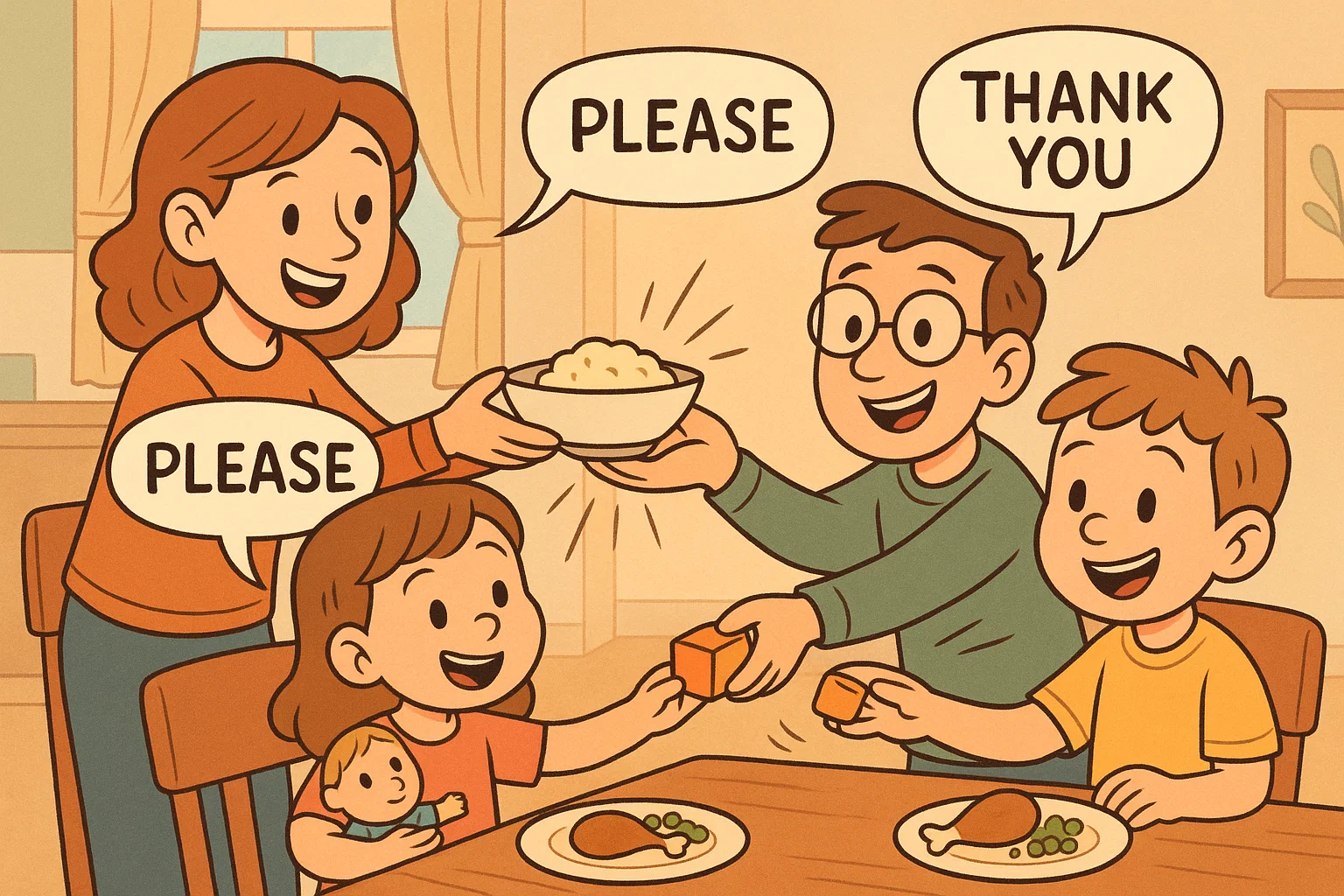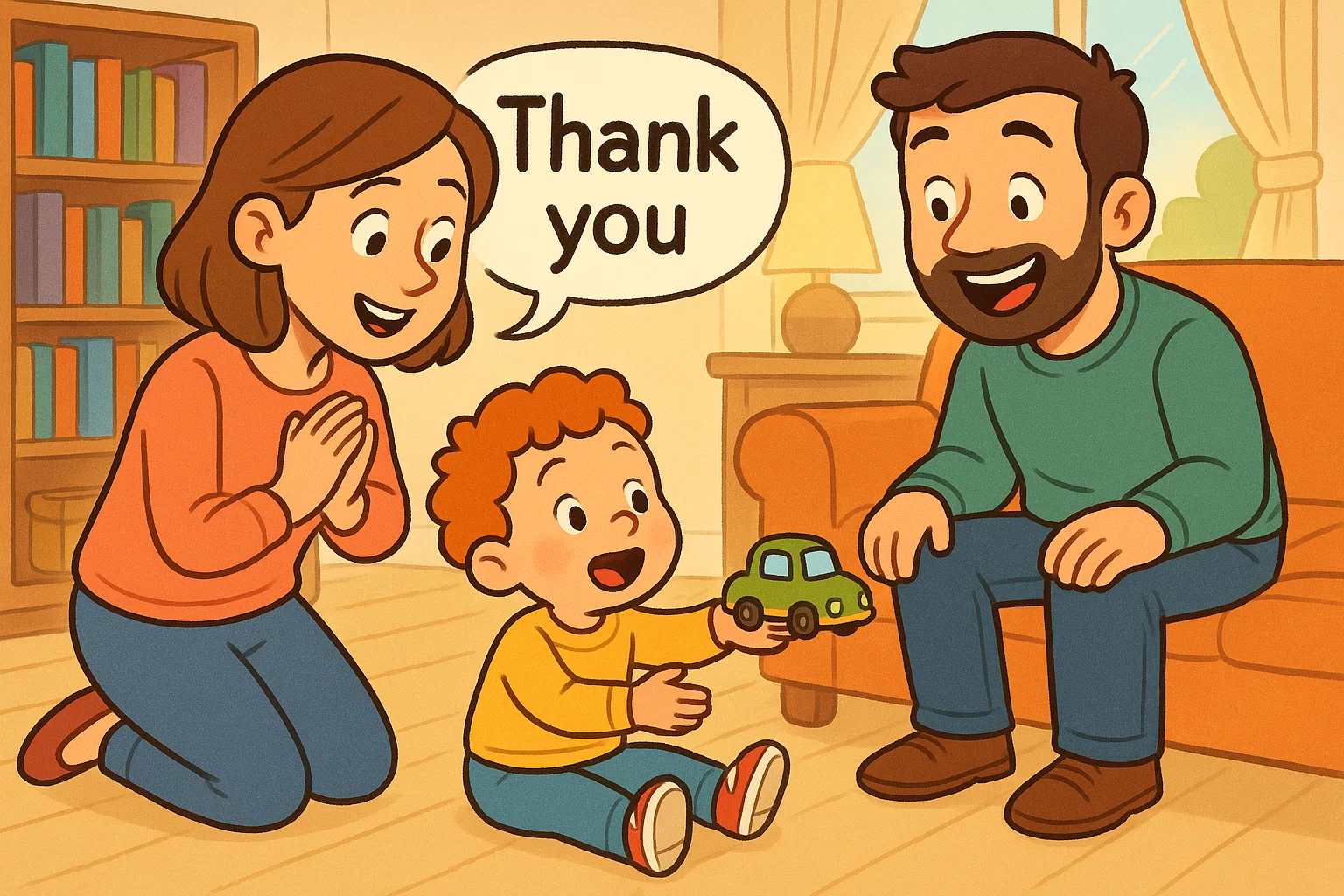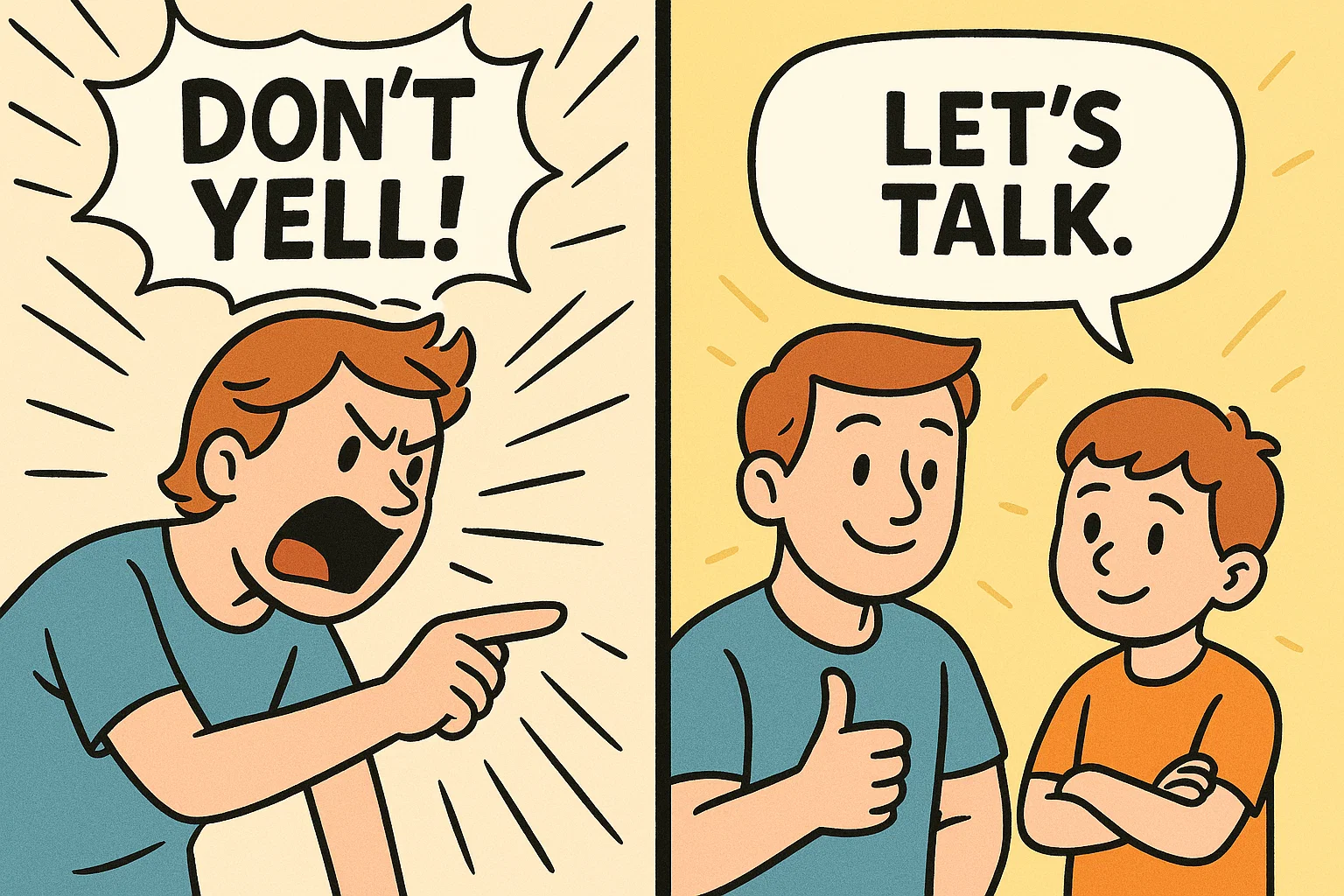Good Manners at Home: Teaching Respect and Kindness Every Day

The foundation of a kind and respectful society begins at home. As parents and caregivers, we shape our children’s learning environment, and few lessons are more important than good manners. They’re not just a set of rules but the heart of emotional intelligence, nurturing respect, empathy, and gratitude.
Teaching etiquette at home helps children understand how their actions affect others, turning self-focus into kindness. A child who practices good manners today grows into a considerate, confident adult tomorrow—someone who thrives in both personal and social relationships.
Why Good Manners Start at Home

The home is a child’s very first school, and parents are the primary educators. It’s where children learn their most important social and emotional cues, long before formal schooling begins. A child’s understanding of social habits, communication, and respectful behaviour is largely shaped by what they observe daily within their family. This safe, familiar environment allows children to practice etiquette without the pressure of the outside world, creating a solid base that promotes emotional growth and social competence.
Role of Parents as Role Models
The single most effective tool for teaching good manners is parental modeling. Children are masterful imitators. Children don’t just hear your words—they carefully watch how you greet others, your tone of voice when frustrated, and your table manners. If you want your child to say “thank you,” you must first consistently express your own gratitude.
For example, when a child sees a parent patiently waiting their turn in a conversation or using a gentle tone, they internalize this behavior as normal. Conversely, if an adult frequently interrupts or uses harsh language, the child is likely to replicate that. You can model kindness and patience by saying, ‘I’m feeling frustrated right now, so I’ll take a deep breath before responding,’ teaching an essential lesson in self-regulation..
Everyday Situations That Teach Respect
The best opportunities for teaching respectful behaviour often hide in plain sight. Daily life offers countless “teachable moments” that make the lesson real and immediate.
Consider the following common scenarios:
- Sharing Toys: Instead of demanding they share, frame it as an act of kindness: “It makes your friend feel happy when you let them have a turn. That’s a very kind thing to do.”
- Saying “Please” and “Thank You”: Make it non-negotiable. If a child asks for a snack without “please,” kindly say, “I’d be happy to get that for you once you use your polite words.”
- Helping with Chores: Asking a child to put their plate in the sink isn’t about getting free help—it’s a lesson in responsibility and contributing to the family unit. This act reinforces the idea that a home runs on collective effort.
Basic Manners Every Family Should Practice
A strong foundation in basic etiquette prepares children to interact confidently with the wider world. Cultivating these habits early ensures that their behaviour is not only appropriate but also truly considerate of others.
Saying “Please,” “Thank You,” and “Sorry”
These three simple phrases are the linguistic cornerstones of good manners. They are powerful tools that acknowledge the effort, kindness, or feelings of others.
| Polite Phrase | Emotional Value & Lesson Taught |
| “Please” | Acknowledges that you are making a request, not a demand. Teaches respectful behaviour and humility. |
| “Thank You” | Expresses gratitude and acknowledges another’s effort or generosity. Makes the giver feel appreciated. |
| “Sorry” | Demonstrates empathy and accountability for a mistake or hurt feeling. Shows a desire to repair a relationship. |
Respecting Personal Space and Privacy
As children learn social rules, respecting boundaries is crucial. This lesson is about recognizing and honoring the autonomy of others.
- Knocking on Doors: Teach them to knock before entering a closed room, whether it’s a sibling’s room or an adult’s home office. This simple action shows respect for personal space.
- Avoiding Interruptions: The impulse to interrupt an adult conversation is natural. Teach them a signal (like placing a hand on your arm) to show they need attention, and promise to acknowledge them as soon as you can. This teaches patience and considerate behaviour.
- Respecting Belongings: This means asking before touching a sibling’s toy or a parent’s device. It’s a core lesson in respecting others’ belongings.
Helping Around the House
Involving children in household tasks is a practical way to reinforce good manners and responsibility. Age-appropriate tasks build cooperation and a sense of belonging.
Simple Age-Appropriate Tasks:
- Putting away their own toys or books.
- Setting a paper napkin or their own cup at the dinner table.
- Wiping up minor spills with a cloth.
- Helping greet a guest by taking their coat.
Table Manners That Build Respect

Family mealtimes are arguably the best daily opportunity to teach etiquette. Table manners are about more than just food; they are about showing respect for the effort put into the meal and for the other people eating with you.
Sitting Properly and Waiting for Everyone
This lesson teaches patience and considerateness. Children should remain seated until the meal is finished (no constant getting up and down). A crucial rule of etiquette is waiting for everyone to be served before starting to eat, a simple but powerful way to show respect for the community at the table. They should also learn the correct way to use cutlery, ensuring a pleasant and polite dining experience.
Speaking Politely at the Table
Mealtimes should be a time for calm, pleasant conversation. The table is not the place for yelling, arguing, or talking with a mouth full of food.
- Encourage “Pass the…”: Instead of reaching across the table, teach your child to ask, “Please pass the bread.”
- No Negative Comments: Teach them that if they do not like a food, they can politely say, “No thank you,” rather than making a face or announcing, “This food is gross,” which could offend the cook.
Cleaning Up After Meals
Teaching children to clear their own place is an act of gratitude for the food and a demonstration of responsibility. It reinforces the idea that everyone contributes. A simple phrase like, “Thank you for the wonderful meal,” is a powerful final lesson in appreciation.
Communication and Respectful Behaviour
Polite and respectful behaviour is most evident in how we communicate. This skill set is vital for developing healthy relationships with peers and adults alike.
Listening Without Interrupting
Learning to actively listen is perhaps the most difficult lesson in etiquette for a young child. It teaches self-control and empathy—the understanding that another person’s thoughts matter. When a child begins to interrupt, gently place a hand on their arm and say, “I see you have something to say, and I want to hear it. Show respect by waiting until I finish my thought.” This lesson reinforces patience and empathy.
Using Kind Words and Tone
A child must understand that the tone in which words are spoken can be just as impactful as the words themselves. A child who says, “Please get me a toy!” in a demanding tone is less polite than one who uses a softer, more considerate voice. Use examples: ‘How do you feel when someone yells at you? It can make others feel the same way.” This helps them understand how their behaviour affects others.
Managing Anger and Apologizing
It’s crucial to teach children that it’s okay to feel angry, but it is not okay to offend others with their actions or words.
- Conflict Resolution: Teach them to take a time-out, count to ten, or use “I feel…” statements instead of blaming.
- Sincere Apologies: A genuine apology requires more than just saying “sorry.” It involves acknowledging the wrong action and stating how they will behave differently next time. This lesson in accountability is vital for the adult they will become.
Teaching Gratitude and Empathy

True good manners are driven by an internal sense of gratitude and empathy, not by external rules. This is the heart of considerate behaviour.
Keeping a Family Gratitude Journal
A simple, daily practice can dramatically increase a child’s awareness of the good things in their life. Each evening, have the family jot down or draw one thing they are grateful for. This reinforces the importance of appreciation and shifts the focus from what they want to what they have.
Recognizing Acts of Kindness
Make kindness a visible, celebrated part of your home. When you see a sibling share a toy or an adult hold a door for someone, point it out. “That was so considerate of you to help your brother clean up! Thank you for showing respect for his things.” This praise should be specific and sincere to reinforce the positive behaviour.
Giving Back Together
Moving beyond the family, engage in activities that extend empathy into the community. Simple acts, such as volunteering at a local food bank or helping a neighbor with yard work, are powerful lessons in service and reinforce the importance of being considerate of others’ needs.
Fun Ways to Reinforce Good Manners
Learning should be fun and engaging! Creative approaches can make etiquette stick much better than stern lectures.
Manners Games and Role-Play
Turn good manners into a game. Role-play situations like having a dinner party or greeting a visitor. You can be the “rude guest” and let the child practice polite corrections. Games like “Manners Charades,” where they act out good and bad behaviour, help children learn to recognize the difference in a fun way.
Storybooks and Movies About Politeness
Children’s media is full of wonderful resources that highlight kindness and respectful behaviour. Choose books or family films that feature characters learning about sharing, friendship, and gratitude. Discuss the lessons after: “How did the boy in the story feel when his friend said ‘thank you’?”
Reward Systems and Positive Reinforcement
Positive reinforcement is highly effective. Instead of focusing on punishment for bad behaviour, focus on consistently recognizing polite and considerate actions. A simple sticker chart for saying “please” or a verbal compliment like, “That’s excellent etiquette!” goes a long way to reinforce the desired actions, ensuring the child feels seen and encouraged.
Common Mistakes Parents Make

Even with the best intentions, parents can sometimes unintentionally undermine their own lessons. Being aware of these common pitfalls can enhance the effectiveness of your manners training.
Yelling or Overreacting
If a parent responds to a child’s interruption or lapse in etiquette with shouting, the child learns that the adult cannot control their own emotions. This undermines the lesson of respectful behaviour. Shouting causes fear and discourages cooperation. Instead, a firm, calm tone is far more effective at conveying the importance of the rule without damaging the trust.
Inconsistency in Rules
If saying “please” is a rule one day but optional the next, the child will struggle to learn the lesson. Children learn best with steady, predictable expectations. Decide what your family’s core etiquette rules are, and reinforce them every single time. This consistency is essential for making good manners a permanent habit.
Forgetting to Model Respect Toward Children
The rule of polite behaviour must go both ways. If an adult expects a child not to interrupt, the adult must also avoid dismissing or shushing the child rudely. If an adult makes a mistake, they should say, “I’m sorry,” showing the child that accountability is a lifelong requirement, not just a lesson for kids. This practice is the purest form of showing respect.
How to Keep Manners a Part of Daily Life
The goal is integration, not complication. Good manners should be woven into the fabric of your day.
Setting Clear House Rules
Post a simple, visual list of your family’s etiquette expectations in a high-traffic area.
Examples of Clear House Rules:
- Always greet guests and say goodbye politely.
- No interrupting; wait your turn to speak.
- Show respect for your siblings’ space and belongings.
- Always use “please” and “thank you.”
Family Meetings and Discussions
Regular, low-pressure discussions about behaviour and feelings help children learn to articulate their needs respectfully. This is a chance to talk about why gratitude is important and to praise the considerate behaviour you’ve observed.
Creating a Respectful Home Atmosphere
Ultimately, the atmosphere of your home is your strongest tool. A home where an adult and child both show respect for one another’s feelings and opinions naturally fosters good manners. When routines are consistent and family values center on kindness, the positive habits naturally reinforce themselves, making etiquette an authentic extension of family life.
Conclusion: Building a Home of Respect, Gratitude, and Love
Teaching good manners is one of the most lasting and significant gifts you can give your child. It goes far beyond knowing which fork to use or remembering to say ‘please.’ It is a comprehensive lesson in empathy, self-control, and respectful behaviour that strengthens family bonds, promotes emotional stability, and paves the way for a socially confident adult. When we consistently reinforce the importance of being polite and considerate, we are not just teaching rules; we are fostering a lifetime of kindness, gratitude, and love. The effort you put in today will echo through your child’s relationships and interactions for decades to come.
